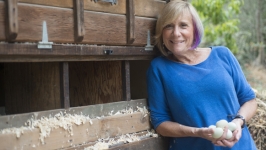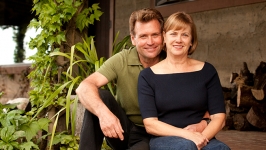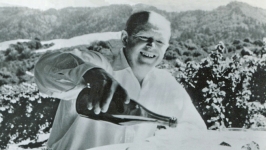Sibella Kraus : The Farm-to-Table Connector
Heralded as a national farm-to-table mover and shaker, this hands-on Bay Area visionary is now shaping local urban edge farming and ecosystems in Santa Clara Valley.
Alice Waters, owner of Berkeley’s famed Chez Panisse restaurant, is rushed. She’s preparing dinner for 600 dignitaries for the Global Climate Action Summit in two days’ time. But she stops to talk about Sibella Kraus—an undisputed national leader in the sustainable food movement and a former chef and produce forager at Chez Panisse.
“Sibella Kraus taught us all to treasure the farmer,” says Alice. “It was her Tasting of Summer Produce events in the 1980s—which brought farmers and restaurants together for the first time—that really began the farm-to-table movement in the Bay Area. Before that, we were buying foods sustainably, but it was difficult to connect directly with the farmers. Sibella changed all that."
That, and much more.
Over the last 40 years, Sibella has played a pivotal role in the transformation of the food movement in the Bay Area and beyond, profoundly reshaping the landscape and business of food and farming. Consider just a few of her other accomplishments:
Sibella spearheaded the formation of the San Francisco Ferry Plaza Farmers Market, the iconic public market that has been emulated across the country.
She founded the Center for Urban Education about Sustainable Agriculture (CUESA), which teaches countless urbanites about the value of fresh, local food.
She counsels local governments across the country on the importance of farms at the urban edge through Sustainable Agriculture Education (SAGE), another nonprofit she started and directs.
And she’s helping San Jose figure out how to create a vibrant food economy both in the city and Coyote Valley.
It’s no wonder that clusters of people wait to speak with her whenever she finishes a speech. Gracious, warm and clearly the most knowledgeable person in the room, Sibella spoke with Edible Silicon Valley about her life’s work, thus far.
Sibella’s relationship to fresh food and agriculture started in early childhood. She grew up in Australia, in a household where gardening and cooking were something you just did. “My mother’s formal education included learning all the biological names of all plants, in English and Latin, and having a garden was a given. My father didn’t have the same upbringing, but he had a great romance about landscapes that complemented my mother’s sense of gardening and sharing food around the table.”
After majoring in European Intellectual History at UC Berkeley, Sibella’s own knack for cooking led her to start a catering company and later join Chez Panisse. But she soon realized that agriculture, not cooking, was her passion. She went back to Berkeley to study agricultural economics while still working at the restaurant. At Chez Panisse she observed something important: Restaurants were frustrated by inadequate access to high-quality regional fare and growers were frustrated by their inability to find appreciative markets.
“With funding from a few restaurants and nonprofits, I started the Farm Restaurant Project, a 22-week study where I visited lots of farmers to learn about what they were growing in their fields, how their prized products and chefs’ needs coincided, how contracts between restaurants and growers could be fashioned and how to efficiently distribute just-picked and perishable produce.”
Tasting of Summer Produce
The culmination of the project was the first Tasting of Summer Produce event in 1983, possibly as seminal in the creation of demand for regional produce in Northern California as the 1976 “Judgment of Paris” that pitted California wines against French wines (a California Cab bested top-ranked Bordeaux). Held at Greens Restaurant, chefs, growers and others gathered to share a remarkable array of summer produce donated by the growers and to share a meal created by chefs.
Alice recalls that she saw and tasted produce she had never seen before or even imagined. “I tasted Bronx grapes for the first time. I started to buy and use them in the restaurant and cornered the market. In fact, I’m using Bronx grapes at the Global Climate Action Summit dinner.”
Over the next eight years, the Tasting of Summer Produce grew to over 100 farmers and restaurants, and the news media began to cover the event as a way to spot food trends. “Golden beets, purple potatoes, white peaches— wow, these were all shocking and newsworthy items at the time,” recalls Sibella with a laugh.
But the bigger trend was the very beginning of the farm-to-table movement. With relationships now forged between farmers and restaurants, interest in organic, locally sourced food was growing.
During this period, Sibella was also launching an organic and specialty crop division for Greenleaf Produce Company, at that time a “natural foods” distributor. Over the course of a few years, she developed relationships with hundreds of specialty crop farmers, almost all of whom she visited, and helped figure out pricing models, small-volume delivery methods, packaging for delicate stone fruit—the full gamut of logistics required to supply restaurants with just-picked, perfect produce.
As if this wasn’t enough for Sibella to undertake, she also began working for the San Francisco Chronicle, writing a weekly food column and features on California farms and agricultural issues. In the middle of this, she started a family, raising two young sons with her husband from their home in Berkeley.
Ferry Plaza Farmers Market
After the 1989 Loma Prieta earthquake, the damaged Embarcadero freeway along the San Francisco Bay was torn down, exposing the waterfront and revealing the perfect location for a permanent public market. Sibella and a few others had long envisioned a market, along the lines of Pike Place Market in Seattle or Granville Island in Vancouver.
It took a few years and the formation of the San Francisco Public Market Collaborative, of which Sibella was a founding member and executive director, to turn the vision into reality.
The first step in 1992 was a one-time farmers market across the Embarcadero from the Ferry Building. Over 50 farmers sold produce and meat and 15 San Francisco restaurants prepared street food; over 10,000 people attended. Its popularity surprised and won over the Port Authority, which had originally resisted the idea. By the next year, the year-round Ferry Plaza Farmers Market, managed by Sibella and her team, was born.
While successful, the Market still needed a boost to bring in larger numbers of people to seek out organic food. In those days, farmers markets were few and far between, with only a handful in the entire Bay Area. People didn’t know much about organic food or the farmers who grew it.
Center for Urban Education and Sustainable Agriculture
According to Sibella, “Farmers were asking why families weren’t shopping at the market, why people were just buying a single peach instead of ingredients for a whole meal.” The need for public education was critical, and it spurred the creation of a sister organization, also headed by Sibella, called the Center for Urban Education and Sustainable Agriculture (CUESA).
Hands-on cooking for kids at the market? Check. Seasonal celebrations for families? Check. Shop with the chef? Yes, of course.
CUESA also expanded programs into the community, organizing willing chefs to cook right in school classrooms and take kids on field trips to farms. Alice helped launch the school gardening movement. Maps provided self-guided tours to 100 agricultural projects throughout the Bay Area.
CUESA’s educational programs and outreach also began to identify some of the sobering issues facing farmers, namely farm worker conditions, small farm viability, pesticide use and farmland preservation. Kraus noted that these issues were trending in a negative direction in the 1990s, and in 2001 Sibella left CUESA to found the nonprofit Sustainable Agriculture Education (SAGE), where she is currently president.
Sustainable Agriculture Education
For the last 18 years, SAGE has contracted with decision makers and stakeholders across the Bay Area on projects to protect farmland at the edges of cities—which she calls “our regional backyard”—and to foster a vibrant food economy. Two of them are right here in Silicon Valley.
The first is the protection and revitalization of the 7,400-acre Coyote Valley on San Jose’s southern border. This last remaining farmland in Santa Clara Valley, which supplied much of the nation’s apricots and prunes over 100 years ago, has been mired in heated debates about its use from competing interests for decades. The uncertainty over its future–industrial parks and housing versus farmland and open space–plus the skyrocketing cost of real estate, prompted city planners to look to SAGE for guidance.
The other project is San Jose Food Works, a comprehensive study and list of recommendations that Sibella compiled to assist San Jose leaders and key partners in elevating food as a driver to advance the city’s goals for economic development, place-making, public health and sustainability. The food industry contributes $2.8 billion to San Jose’s economy but it could be more if the city created a facility and related infrastructure to serve co-located food wholesalers, processors and specialty food producers as well as local farmers. SAGE is actively studying the feasibility of such a project now.
“Sibella Kraus doesn’t motivate by fear, she motivates by hope,” says Andrea Mackenzie, general manager of the Santa Clara Valley Open Space Authority. “She brings people together, finds common ground and shows how investing in food and farming is good for a city’s health, the environment and a sense of place. Who could not support that policy?”
Main photo by Laurie Schutters / Other photos provided courtesy of CUESA | Coyote Valley photos by Edible Staff.
Living Like a Local: Behind the Scenes with Sibella Kraus
- She’s a dancer, with Afro-Cuban folkloric and salsa a current passion.
- Her large garden includes seasonal Trombetta squash, Romano beans, herbs, nettles and recently she added citrus, including Australian limes and Meiwa kumquats.
- Her husband built the 10-person dining table that is most often filled with friends and family.
- Her cooking philosophy: Get quality ingredients in season and don’t do too much to them.
![]()
- A favorite meal to serve to her guests is paella on the grill.
- She always buys her eggs from Riverdog Farms and melons and almond butter from Full Belly Farm.





